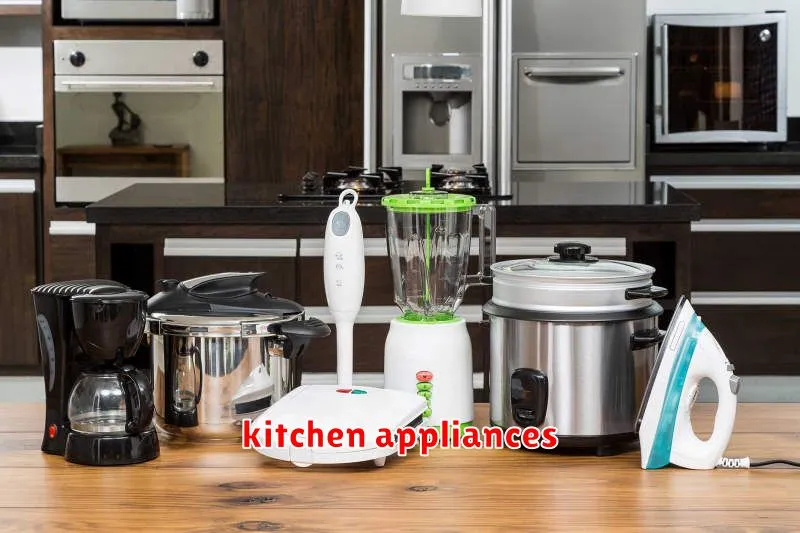Are you dreaming of transforming your kitchen into a culinary haven? The right appliances can make all the difference, empowering you to whip up gourmet meals and elevate your cooking experience to new heights. Whether you’re a seasoned chef or a beginner, kitchen appliances are essential tools that can simplify your cooking process, inspire creativity, and bring joy to your culinary adventures.
In this article, we’ll explore the 15 most popular kitchen appliances that every home chef should consider adding to their arsenal. From essential appliances like ovens and refrigerators to versatile tools like blenders and food processors, we’ll delve into the features, benefits, and must-have qualities of each appliance, helping you create a kitchen that’s as functional as it is stylish.
Refrigerator
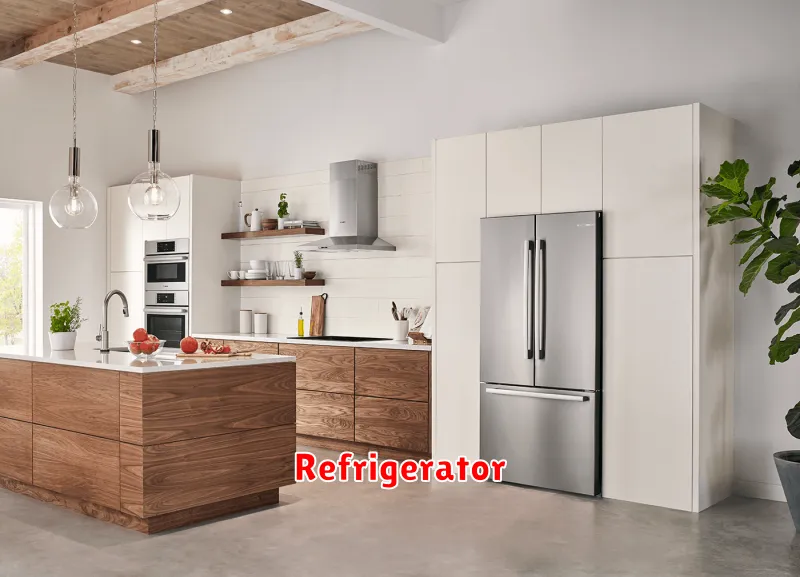
A refrigerator is a common household appliance that is used to keep food and beverages cold. It works by using a refrigerant, which is a substance that absorbs heat when it evaporates and releases heat when it condenses. This process cools the air inside the refrigerator and keeps the food cold.
Refrigerators come in a variety of sizes and styles, and they can be found in almost every home. They are essential for keeping food fresh and safe to eat. In addition to cooling, many refrigerators also have features such as ice dispensers, water filters, and freezers.
The first refrigerators were invented in the early 19th century, and they were powered by ice. However, these early refrigerators were bulky and inefficient. In the early 20th century, the first electric refrigerators were developed, and they quickly became popular. Today, refrigerators are one of the most common appliances in the world.
Here are some tips for using a refrigerator properly:
- Keep the refrigerator at a temperature of 40°F (4°C) or below.
- Store food in airtight containers to prevent spoilage.
- Do not overload the refrigerator.
- Clean the refrigerator regularly to prevent bacteria growth.
By following these tips, you can help to keep your refrigerator clean, efficient, and safe to use.
Range or Cooktop
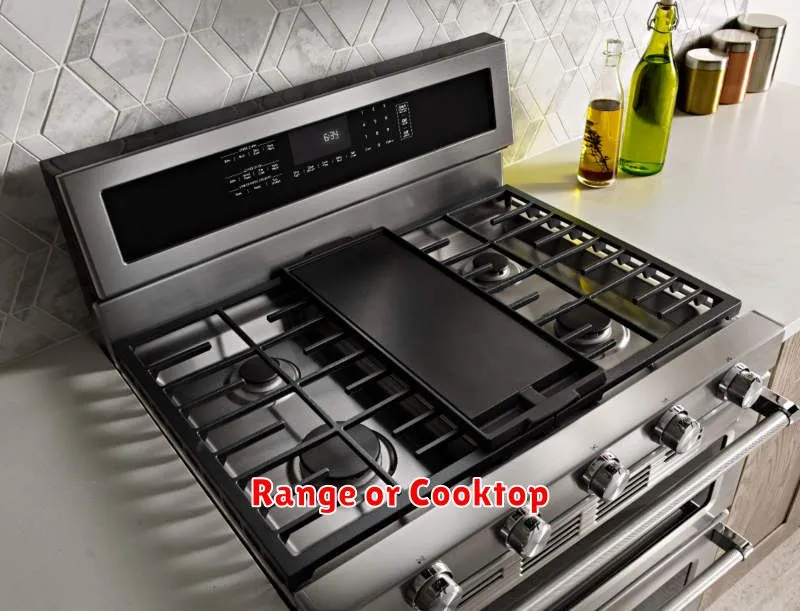
When it comes to cooking, having the right appliance is crucial. Two popular options are ranges and cooktops. Both offer different advantages and disadvantages, making it essential to understand their differences before making a purchase. This blog post will delve into the details of ranges and cooktops, helping you determine which appliance suits your needs best.
Range
A range is a freestanding appliance that combines an oven and a cooktop in one unit. It’s a popular choice for those who want a complete cooking solution in a single appliance. Ranges are available in various sizes and configurations, including gas and electric options.
Advantages of a Range
- Space-saving: A range eliminates the need for separate appliances, maximizing kitchen space.
- Convenience: Having the oven and cooktop in one unit provides a streamlined cooking experience.
- Variety of options: Ranges are available in various styles, sizes, and features, such as convection ovens and griddles.
Disadvantages of a Range
- Limited countertop space: Ranges take up significant counter space, which might be a concern for smaller kitchens.
- Less flexibility: The oven and cooktop are fixed together, limiting the flexibility to rearrange the appliances.
Cooktop
A cooktop is a separate appliance that only includes the cooking surface, while the oven is typically housed in a separate cabinet. Cooktops come in different types, including gas, electric, and induction.
Advantages of a Cooktop
- Flexibility: Cooktops can be installed anywhere on the countertop, allowing you to customize your kitchen layout.
- More countertop space: Since the oven is separate, you have more counter space for prepping and cooking.
- Greater customization: You can choose a cooktop that best suits your cooking style and preferences, such as gas or induction.
Disadvantages of a Cooktop
- Requires separate oven: You’ll need to purchase a separate oven, which can add to the overall cost.
- Less space-saving: Compared to a range, a cooktop and separate oven take up more space.
The choice between a range and a cooktop ultimately depends on your individual needs and preferences. A range is an ideal choice for those looking for a space-saving and convenient cooking solution, while a cooktop offers greater flexibility and customization. Consider your kitchen size, cooking style, and budget before making your decision.
Ovens
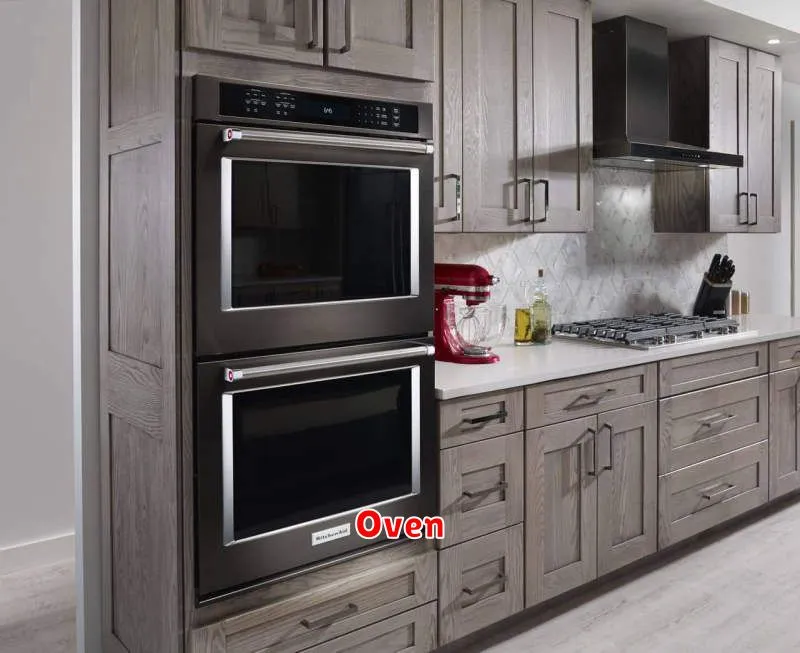
An oven is a typically enclosed space, often made of metal, that uses heat to cook, bake, or roast food. Ovens are a staple in most kitchens and are used for a wide variety of culinary tasks, from baking bread and cakes to roasting vegetables and meats. They come in various sizes and styles, with different features and functions depending on the specific model.
The basic principle behind oven operation is the transfer of heat to the food. This heat can be generated by various methods, including gas, electricity, or even wood-burning. Most modern ovens use either gas or electric heating elements.
Gas ovens utilize a burner that heats up the oven cavity, while electric ovens use heating elements embedded within the oven walls. Some ovens have a combination of both gas and electric heating elements, providing greater flexibility in cooking options.
Ovens are often equipped with various features that enhance their functionality. These can include:
- Temperature controls: Allow you to set the desired temperature for cooking.
- Timer: Sets a cooking time and automatically turns off the oven when it’s done.
- Convection fan: Circulates hot air within the oven for more even cooking.
- Broiler: An element located at the top of the oven that uses intense heat to brown or grill food.
- Self-cleaning function: Makes cleaning the oven easier by using high heat to burn off grease and food residue.
Choosing the right oven depends on your specific needs and preferences. Consider factors such as the size of your kitchen, cooking frequency, budget, and desired features. There are many different types of ovens available, including freestanding, built-in, and countertop models.
Ovens are an essential appliance for any kitchen, allowing you to cook a wide variety of dishes and enjoy delicious meals at home. With proper care and maintenance, your oven can provide years of reliable service.
Microwave
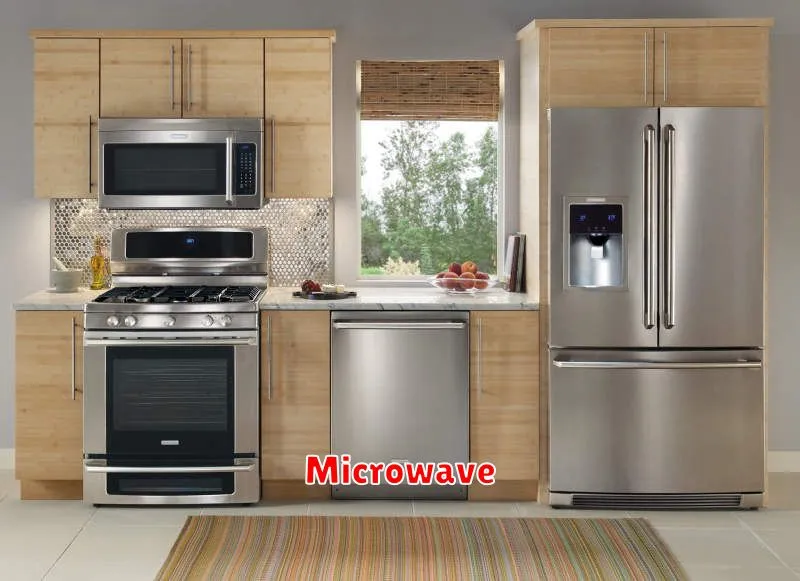
A microwave oven, often simply called a microwave, is a kitchen appliance that heats food by exposing it to electromagnetic radiation in the microwave frequency range. This radiation causes water molecules in food to vibrate rapidly, generating heat that cooks the food. Microwaves are a safe and efficient way to cook food, and they are becoming increasingly popular in homes around the world.
Microwaves work by using a device called a magnetron to generate microwaves. The magnetron is a vacuum tube that converts electrical energy into microwave energy. The microwaves are then directed into the oven cavity, where they interact with the food. Water molecules in food absorb the microwaves, causing them to vibrate rapidly. This vibration generates heat, which cooks the food. Microwaves can heat food much faster than conventional ovens because they heat the food directly, rather than relying on heat transfer through air or metal.
Microwaves are a versatile appliance that can be used for a wide variety of cooking tasks. They can be used to reheat leftovers, cook frozen meals, and even cook fresh food. Microwaves are also energy-efficient, as they use less energy than conventional ovens. In addition, microwaves are relatively inexpensive to operate.
However, there are also some drawbacks to using microwaves. One concern is that microwaves can potentially leach chemicals from plastic containers into food. Another concern is that microwaves can cook food unevenly, which can result in undercooked or overcooked spots. It is important to use microwave-safe containers and to rotate food during cooking to ensure even heating.
Overall, microwaves are a convenient and efficient way to cook food. They offer a number of benefits, including speed, energy efficiency, and versatility. However, it is important to be aware of the potential drawbacks of using microwaves before using them to cook food.
Dishwasher
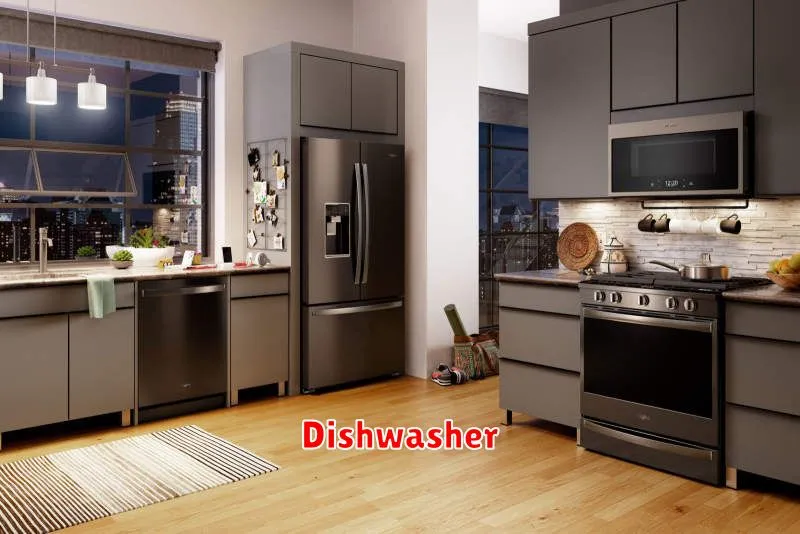
A dishwasher is a kitchen appliance that washes dishes and other utensils. It is a common appliance in many households and can be found in a variety of sizes and styles. Dishwashers use water, detergent, and heat to clean dishes. The water is heated to a high temperature and sprayed onto the dishes, along with detergent. The dishes are then rinsed with clean water and dried.
There are several different types of dishwashers available, including built-in, freestanding, and portable dishwashers. Built-in dishwashers are installed into cabinets and are typically found in modern kitchens. Freestanding dishwashers are separate appliances that can be placed anywhere in the kitchen. Portable dishwashers are small and can be moved easily from one location to another.
When choosing a dishwasher, it is important to consider factors such as size, capacity, features, and price. The size of the dishwasher should be appropriate for the amount of dishes you need to wash. The capacity of the dishwasher is the number of place settings it can hold. Features to consider include noise level, energy efficiency, and different wash cycles. Price is also an important factor to consider, as dishwashers can range in price from a few hundred dollars to several thousand dollars.
Dishwashers can be a convenient and efficient way to clean dishes. They can save time and energy, and they can help to reduce the spread of germs. However, it is important to use dishwashers properly and to follow the manufacturer’s instructions. Overloading the dishwasher can damage it and lead to poor cleaning results. It is also important to use the correct type of detergent and to rinse dishes before loading them into the dishwasher.
In conclusion, dishwashers are a popular and convenient kitchen appliance that can save time and energy. When choosing a dishwasher, it is important to consider factors such as size, capacity, features, and price. With proper care and maintenance, a dishwasher can provide years of reliable service.
Range Hood or Vent

When it comes to your kitchen, choosing the right ventilation system is crucial for maintaining a clean, comfortable, and safe environment. Two popular options are range hoods and vents. While both serve a similar purpose, they differ significantly in their design, functionality, and installation.
Range Hoods
A range hood is a dedicated appliance designed specifically for removing cooking odors, smoke, and grease from the air above your stove. They are typically mounted above the range and come in various styles, from sleek and modern to traditional and ornate. Range hoods often feature powerful fans, filters, and sometimes even lighting to improve visibility while cooking.
Types of Range Hoods
- Under-cabinet hoods: These are typically less expensive and easy to install, fitting discreetly under your kitchen cabinets.
- Island hoods: Ideal for kitchens with islands, these hoods offer stylish designs and powerful ventilation.
- Wall-mounted hoods: These hoods are commonly found in traditional kitchens and offer a range of styles.
Advantages of Range Hoods
- Effective ventilation: Range hoods are designed to efficiently remove cooking fumes and odors.
- Improved air quality: By removing pollutants from the air, range hoods contribute to a healthier kitchen environment.
- Variety of styles: You can find range hoods in various styles to complement your kitchen’s design.
- Additional features: Some range hoods offer features like built-in lighting, timers, and remote control.
Disadvantages of Range Hoods
- Higher cost: Range hoods can be more expensive than vents.
- Installation complexity: Installing a range hood can require professional help depending on the type and configuration.
- Maintenance: Range hoods need regular cleaning of filters and fans.
Vents
Vents, also known as ductless fans, are simpler ventilation devices. They are typically installed in the ceiling or wall and connect to a duct that exhausts air to the outside. Vents are not as specialized as range hoods and might not be as effective at removing specific cooking odors or grease.
Advantages of Vents
- Lower cost: Vents are generally less expensive than range hoods.
- Easier installation: Vents are typically easier to install than range hoods.
- Less maintenance: Vents require less maintenance than range hoods.
Disadvantages of Vents
- Less effective ventilation: Vents may not be as efficient at removing cooking odors and grease.
- Limited features: Vents usually lack features like lighting and timers found in range hoods.
- Potentially noisy: Some vents can be noisy during operation.
Choosing the Right Option
The best choice for you depends on your specific needs, budget, and kitchen layout. If you are concerned about removing cooking odors, grease, and smoke efficiently, a range hood is a better option. However, if you are looking for a more budget-friendly solution with easy installation, a vent might be a better fit. Consult with a professional to determine the most appropriate ventilation system for your kitchen.
Ultimately, the best way to make a decision is to weigh the pros and cons of each option and consider your individual preferences. By choosing the right ventilation system, you can create a clean, comfortable, and safe kitchen environment.
Garbage Disposal
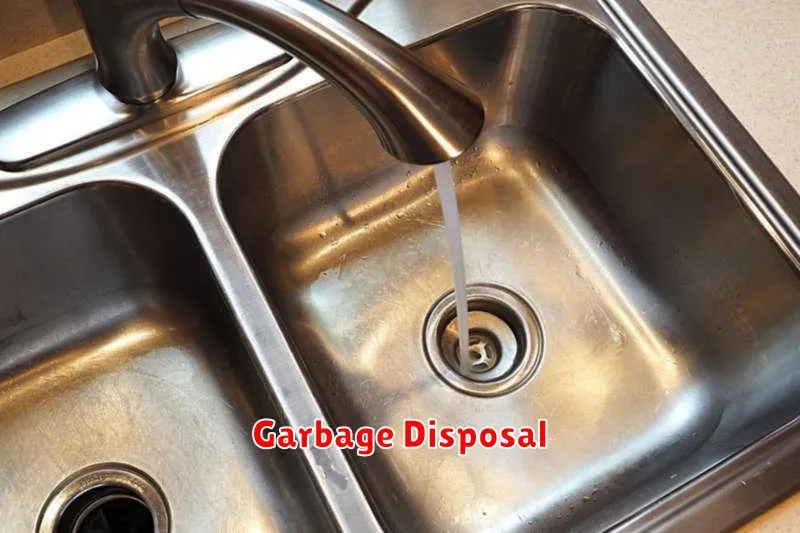
A garbage disposal is a kitchen appliance that grinds up food waste into small particles that can be safely flushed down the drain. It is a convenient way to dispose of food scraps, but it is important to use it correctly to avoid damaging the unit or causing plumbing problems.
Benefits of a Garbage Disposal:
- Reduces food waste: Garbage disposals can grind up food scraps, making it easier to dispose of them. This can reduce the amount of food waste that goes to landfills.
- Convenient: Garbage disposals are a convenient way to dispose of food scraps, as you can simply toss them into the sink and turn on the disposal.
- Clean kitchen: Garbage disposals can help to keep your kitchen clean and odor-free by eliminating food scraps.
How to Use a Garbage Disposal:
- Turn on the cold water before turning on the disposal. This will help to lubricate the blades and flush away the ground-up food scraps.
- Feed the food scraps into the disposal slowly. Do not overload the disposal.
- Use a blunt object, such as a wooden spoon, to push the food scraps down the disposal. Never use your fingers or a sharp object.
- Let the disposal run for a few seconds after you have finished feeding it food scraps. This will help to ensure that all of the scraps are ground up and flushed away.
- Turn off the disposal before turning off the water. This will help to prevent clogs.
What not to put in a garbage disposal:
- Bones: Bones are too hard for the disposal blades to grind up.
- Grease: Grease can solidify and clog the drain.
- Fibrous foods: Fibrous foods, such as celery, corn husks, and onion skins, can wrap around the disposal blades and cause them to jam.
- Egg shells: Egg shells are sharp and can damage the disposal blades.
- Starchy foods: Starchy foods, such as potatoes and pasta, can stick to the disposal blades and cause them to jam.
- Coffee grounds: Coffee grounds can clog the drain.
- Plastic: Plastic is not biodegradable and can damage the disposal blades.
- Metal: Metal can damage the disposal blades.
- Glass: Glass can damage the disposal blades.
Maintaining your Garbage Disposal:
- Clean your disposal regularly. You can clean your disposal by running cold water for a few seconds and then dropping in a few ice cubes. The ice cubes will help to clean the blades.
- Use a disposal cleaner periodically. Disposal cleaners can help to remove grease and other debris that can build up in the disposal.
- Avoid overloading the disposal. Overloading the disposal can cause it to jam.
- Check the disposal blades regularly. If the blades are damaged, they can cause the disposal to jam or break down.
By following these tips, you can help to ensure that your garbage disposal is working properly and safely.
Blenders
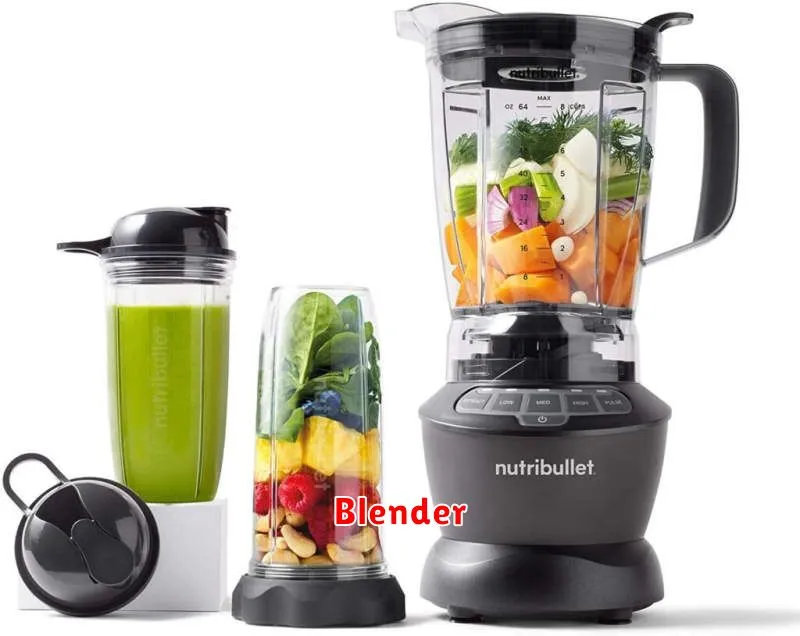
A blender is a kitchen appliance used to mix, crush, and liquefy food and other ingredients. It typically consists of a container with a rotating blade at the bottom, driven by an electric motor. Blenders are versatile tools that can be used for a wide range of culinary tasks, from making smoothies and sauces to grinding nuts and spices.
The basic principle of a blender is simple: a motor spins a blade at high speed, which breaks down ingredients into smaller pieces. The speed and power of the motor, along with the design of the blade, determine the texture of the final product. Some blenders have multiple speed settings, allowing users to control the coarseness or smoothness of the mixture.
Blenders are available in a variety of sizes and styles, with features that cater to different needs and preferences. Some popular types include:
- Immersion blenders: These handheld blenders are ideal for blending directly in a pot or container, making them great for soups, sauces, and dips.
- Countertop blenders: These larger blenders are typically used for smoothies, shakes, and frozen desserts.
- Personal blenders: These compact blenders are perfect for single servings or small batches.
When choosing a blender, consider factors like:
- Power: Higher wattage generally translates to more powerful blending.
- Capacity: Choose a blender with a suitable size for your needs.
- Speed settings: Multiple speeds allow for greater control over texture.
- Features: Look for features like pulse settings, ice crushing capabilities, and self-cleaning options.
Blenders are an essential appliance for any kitchen, offering a convenient and efficient way to prepare a wide variety of dishes. From smoothies to soups to sauces, the possibilities are endless with a quality blender.
Food Processor
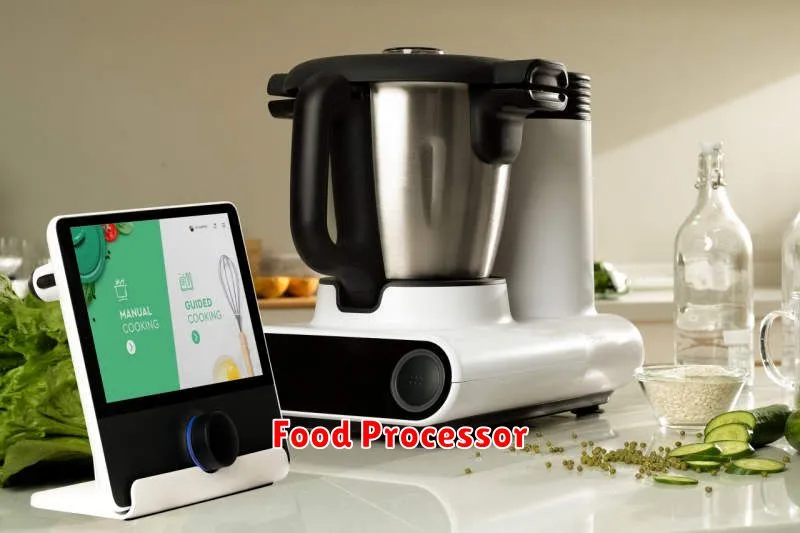
A food processor is a kitchen appliance that can chop, slice, dice, shred, grate, and puree food. It is a versatile appliance that can be used for a variety of cooking tasks, from preparing vegetables for a salad to making a homemade soup. Food processors come in a variety of sizes and with different features, so it is important to choose one that is right for your needs.
One of the main benefits of using a food processor is that it can save you time and effort in the kitchen. For example, you can chop an entire onion in seconds with a food processor, whereas it would take you much longer to do it by hand. Food processors can also be used to create consistent results, which is especially helpful when you are preparing food for a large group of people.
Another benefit of using a food processor is that it can help you to eat healthier. By making it easier to prepare fruits and vegetables, a food processor can encourage you to incorporate more of these healthy foods into your diet. You can also use a food processor to make your own sauces and dressings, which can be a healthier alternative to store-bought versions.
If you are looking for a kitchen appliance that can help you to save time, eat healthier, and enjoy your cooking more, a food processor is a great option. With a little research, you can find the perfect food processor for your needs.
Coffee Maker
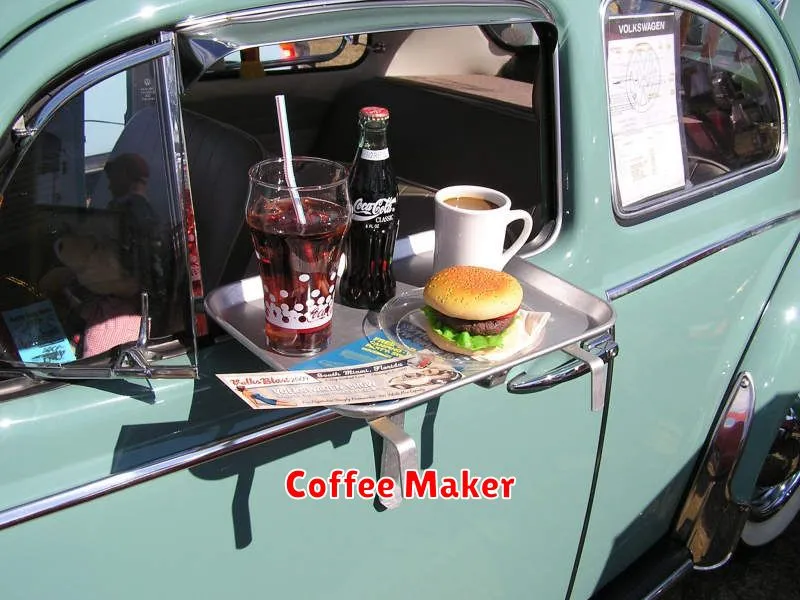
A coffee maker is a kitchen appliance that brews coffee by passing hot water through ground coffee beans. Coffee makers come in a variety of styles, each with its own unique features and benefits. Some of the most popular types of coffee makers include:
- Drip coffee makers are the most common type of coffee maker. They work by dripping hot water through a filter containing ground coffee beans. Drip coffee makers are generally inexpensive and easy to use.
- French press coffee makers use a plunger to press coffee grounds to the bottom of a carafe, resulting in a strong, full-bodied cup of coffee. French press coffee makers are known for their ability to brew coffee with a rich, flavorful aroma.
- Espresso machines are used to make espresso, a concentrated coffee beverage. Espresso machines use high pressure to force hot water through finely ground coffee beans. Espresso machines can be expensive, but they offer a wide range of brewing options.
- Cold brew coffee makers brew coffee using cold water over an extended period of time. Cold brew coffee makers produce a coffee with a smooth, less acidic taste.
- Pour-over coffee makers use a filter cone to pour hot water over ground coffee beans. Pour-over coffee makers allow for a greater degree of control over the brewing process, resulting in a cup of coffee that is tailored to your specific preferences.
When choosing a coffee maker, it is important to consider your individual needs and preferences. Factors to consider include:
- Brewing method: Drip, French press, espresso, cold brew, or pour-over.
- Capacity: How many cups of coffee do you need to brew at a time?
- Features: Programmable timer, automatic shut-off, keep-warm function, grinder.
- Price: Coffee makers range in price from a few dollars to hundreds of dollars.
No matter what your coffee preferences are, there is a coffee maker out there that is perfect for you. With a little research, you can find the perfect coffee maker to brew your favorite cup of coffee.
Toaster
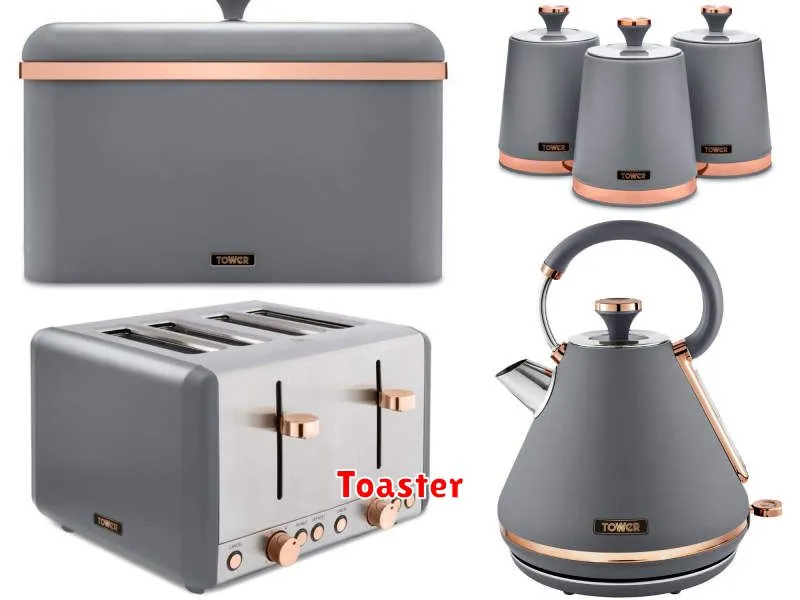
A toaster is a kitchen appliance used to brown or toast bread, pastries, and other food items. It typically consists of a heating element that radiates heat onto the food, causing it to brown and become crisp. Toasters come in a variety of designs and features, with some offering adjustable browning levels, crumb trays, and automatic shutoff functions.
How Toasters Work
The basic principle of a toaster is simple. It uses resistance heating to generate heat. The heating element is typically made of nichrome wire, which has a high resistance to the flow of electricity. When electricity is passed through the wire, it generates heat. This heat is then transferred to the bread or other food items placed in the toaster.
Most toasters have a browning control that allows you to adjust the amount of heat applied to the bread. This control typically has multiple settings, ranging from light brown to very dark brown. The higher the setting, the more heat is applied, resulting in a darker toast.
Types of Toasters
There are several types of toasters available on the market, each with its own unique features and benefits. Some common types include:
- Slot Toasters: These are the most common type of toaster. They have two slots for toasting bread, pastries, or other food items.
- Four-Slice Toasters: As the name suggests, these toasters have four slots, allowing you to toast multiple slices of bread at once.
- Convection Toasters: These toasters use convection technology to distribute heat evenly throughout the food. This results in more consistent browning and crisping.
- Toaster Ovens: These appliances combine the functionality of a toaster and a small oven. They can be used to toast bread, bake cookies, or roast small meals.
Tips for Using a Toaster
Here are some tips for using a toaster effectively:
- Use the correct setting: Adjust the browning control to your desired level of toast.
- Don’t overcrowd the slots: Avoid putting too many slices of bread in the toaster at once, as this can lead to uneven browning.
- Clean the crumb tray regularly: A buildup of crumbs can cause a fire hazard.
- Unplug the toaster when not in use: This helps prevent accidents.
A toaster is an essential appliance for any kitchen, providing a quick and easy way to enjoy crispy and delicious toast. With a variety of models available, you can find the perfect toaster to meet your needs and preferences.
Stand Mixer
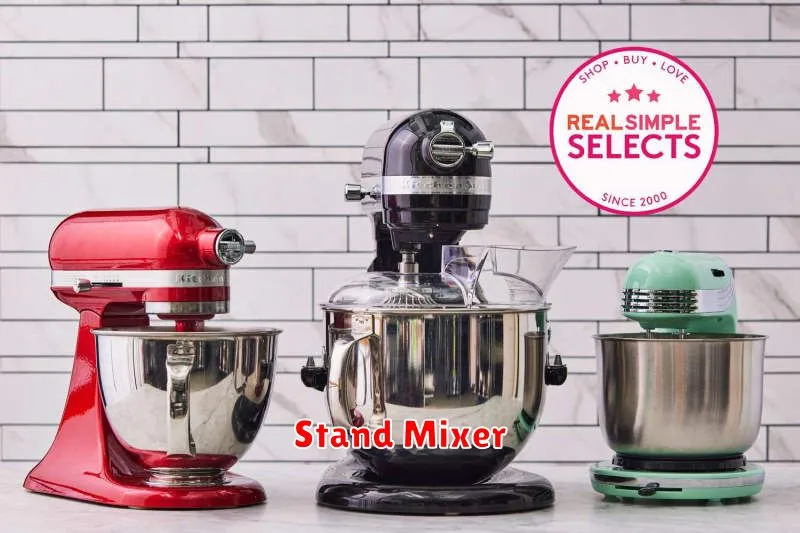
A stand mixer is a kitchen appliance that uses a rotating bowl to mix ingredients. It is a versatile tool that can be used for a wide variety of tasks, from making bread and cookies to whipping cream and frosting cakes.
Stand mixers are typically powered by an electric motor and have a variety of attachments that can be used for different tasks. Some common attachments include a paddle attachment for mixing batter, a dough hook for kneading dough, and a whisk attachment for whipping cream and egg whites.
Types of Stand Mixers
There are two main types of stand mixers: planetary mixers and spiral mixers.
Planetary mixers are the most common type of stand mixer. They have a rotating bowl and a central mixing head that rotates in the opposite direction. This creates a swirling motion that helps to mix ingredients evenly.
Spiral mixers are less common than planetary mixers but are often preferred for kneading heavy dough, such as bread dough. They have a spiral-shaped mixing arm that rotates around the bowl, which helps to develop the gluten in the dough.
Benefits of Using a Stand Mixer
There are many benefits to using a stand mixer:
- Convenience: Stand mixers are very convenient to use. They do most of the work for you, so you can relax and focus on other tasks.
- Versatility: Stand mixers can be used for a wide variety of tasks, from baking to making sauces and dips.
- Consistency: Stand mixers help to ensure that your ingredients are mixed evenly, resulting in more consistent results.
- Time-Saving: Stand mixers can help you save time in the kitchen, especially when it comes to tasks like kneading dough and whipping cream.
Factors to Consider When Choosing a Stand Mixer
When choosing a stand mixer, there are a few factors to consider:
- Size: Choose a stand mixer that is the right size for your needs. If you bake a lot, you may want to choose a larger mixer. If you only bake occasionally, a smaller mixer may be sufficient.
- Power: The power of the motor will determine how much dough the mixer can handle. If you plan on making heavy dough, you will need a mixer with a powerful motor.
- Attachments: Consider the attachments that are included with the mixer. Some mixers come with a variety of attachments, while others only come with the basics.
- Price: Stand mixers can range in price from a few hundred dollars to over a thousand dollars. Consider your budget when choosing a stand mixer.
A stand mixer is a valuable investment for any home baker. It can help you make delicious and consistent baked goods with ease. By considering the factors above, you can choose the right stand mixer for your needs.
Slow Cooker
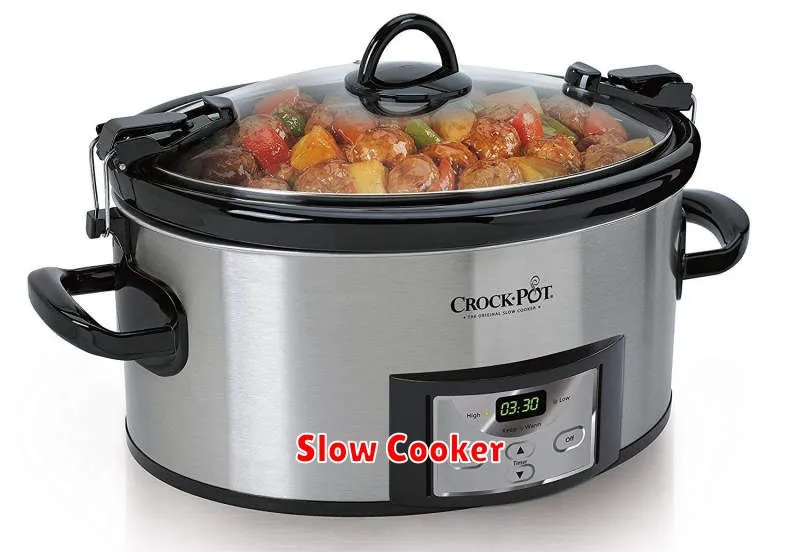
A slow cooker, also known as a crock pot, is a kitchen appliance that cooks food slowly at a low temperature. It is a popular choice for busy families and individuals who want to make delicious and easy meals. Slow cookers are versatile and can be used to prepare a wide variety of dishes, from soups and stews to roasts and desserts.
Benefits of Using a Slow Cooker
There are many benefits to using a slow cooker. Some of the most notable benefits include:
- Convenience: Slow cookers are incredibly convenient because they require minimal attention. You can simply add your ingredients, set the timer, and let the slow cooker do the rest. This makes them ideal for busy weeknights or for meal prepping.
- Easy to use: Slow cookers are very simple to use. They have a few basic settings, such as low, high, and warm, and most models come with a timer.
- Tender and flavorful food: Slow cookers are great for tenderizing tough cuts of meat and developing rich flavors. The slow cooking process allows the flavors to meld and the meat to become incredibly tender.
- Energy efficient: Slow cookers use less energy than traditional ovens or stovetops. This can help to reduce your energy consumption and save money on your utility bills.
Types of Slow Cookers
There are a variety of slow cookers available on the market, ranging in size, shape, and features. Here are some of the most common types:
- Oval slow cookers: These are the most common type of slow cooker and are great for preparing larger meals, such as roasts and whole chickens.
- Round slow cookers: Round slow cookers are a good choice for smaller meals, such as soups and stews.
- Multi-cookers: These slow cookers have multiple functions, such as sauteing, steaming, and baking. They are a great option for those who want to get the most out of their appliance.
Tips for Using a Slow Cooker
Here are a few tips for getting the most out of your slow cooker:
- Don’t overcrowd the slow cooker: If you add too much food to the slow cooker, it won’t cook evenly.
- Use the correct settings: Low settings are best for long cooking times, while high settings are better for shorter cooking times.
- Don’t stir too much: Stirring too often can disrupt the cooking process. It is best to stir only a few times throughout the cooking process.
- Use a slow cooker liner: This will make cleanup a breeze.
Slow cookers are a great way to prepare delicious and easy meals. They are convenient, easy to use, and can help you create flavorful and tender dishes. With a little practice, you will be able to master the art of slow cooking and enjoy the benefits of this versatile kitchen appliance.
Pressure Cooker
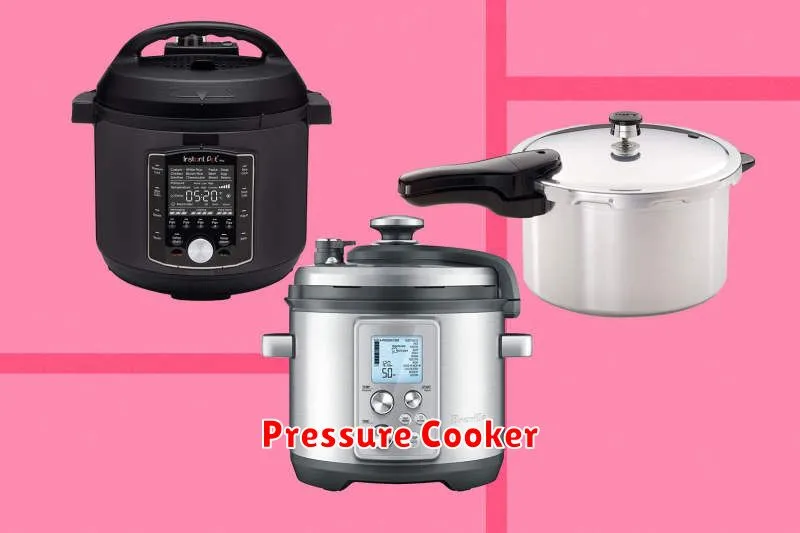
A pressure cooker is a pot with a tightly sealed lid that traps steam and increases the boiling point of water, allowing food to cook faster and more efficiently. It is a versatile kitchen appliance that can be used to prepare a wide range of dishes, from stews and soups to meats and vegetables.
The main advantage of using a pressure cooker is that it reduces cooking time significantly. This is because the increased pressure inside the cooker forces steam to condense back into water, which creates a higher boiling point. The higher boiling point allows food to cook faster and more evenly.
Another advantage of using a pressure cooker is that it helps to preserve nutrients. The shorter cooking time means that less heat is used, which can help to preserve the vitamins and minerals in food. Additionally, the airtight seal prevents nutrients from escaping during cooking.
Pressure cookers are also energy-efficient. Since they cook food faster, they use less energy than traditional methods, such as stovetop cooking or baking. This can help to save money on your energy bills and reduce your carbon footprint.
However, there are some safety concerns that you should be aware of when using a pressure cooker. It is important to follow the manufacturer’s instructions carefully and to use the correct cooking times and pressure settings. It is also important to ensure that the pressure cooker is properly sealed and to vent the steam before opening the lid.
Despite the potential safety concerns, pressure cookers are a safe and convenient way to prepare delicious meals. They are a great option for busy people who want to save time and energy in the kitchen.
In conclusion, a pressure cooker is a valuable kitchen appliance that offers numerous advantages, including reduced cooking time, nutrient preservation, and energy efficiency. While there are safety concerns to be aware of, they can be mitigated by following manufacturer’s instructions and using the pressure cooker safely. If you are looking for a way to speed up your cooking process and make healthy and delicious meals, a pressure cooker is a worthwhile investment.
Air Fryer
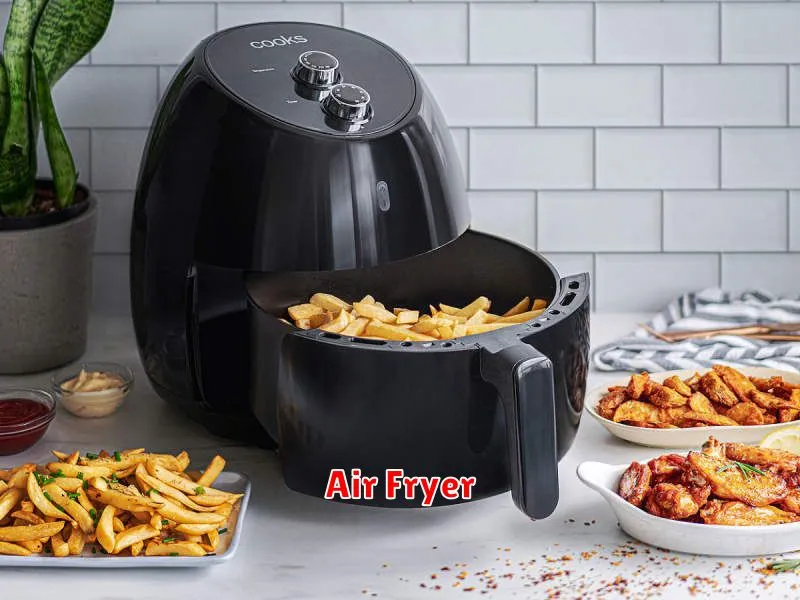
An air fryer is a kitchen appliance that cooks food by circulating hot air around it. This method of cooking is similar to deep frying, but it uses much less oil. As a result, air-fried foods are generally considered to be healthier than deep-fried foods. Air fryers are becoming increasingly popular, as they offer a quick and easy way to cook a variety of foods.
Air fryers work by using a fan to circulate hot air around the food. This hot air cooks the food quickly and evenly, giving it a crispy texture. Air fryers can be used to cook a variety of foods, including french fries, chicken wings, vegetables, and even desserts. Some air fryers also come with accessories, such as rotisserie baskets and baking pans, which can be used to cook a wider variety of foods.
There are many benefits to using an air fryer. Air-fried foods are generally lower in calories and fat than deep-fried foods. Air fryers are also quick and easy to use, and they can be cleaned easily. In addition to this, air fryers are very versatile and can be used to cook a wide variety of foods.
There are a few things to keep in mind when using an air fryer. First, it is important to preheat the air fryer before cooking. Second, it is important to not overcrowd the air fryer, as this can prevent the food from cooking evenly. Lastly, it is important to keep an eye on the food while it is cooking, as it can burn quickly.
If you are looking for a healthy and convenient way to cook food, an air fryer may be the right appliance for you. They are a great way to cook a variety of foods, and they can be cleaned easily. If you are new to using an air fryer, there are many online resources available to help you get started.
Overall, air fryers are a great addition to any kitchen. They are versatile, easy to use, and can help you cook healthier meals. If you are looking for a way to reduce your fat intake and enjoy crispy, delicious food, an air fryer is definitely worth considering.

